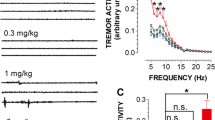Abstract
Rationale. Ayahuasca, a South American psychotropic plant tea, combines the psychedelic agent and 5-HT2A/2C agonist N,N-dimethyltryptamine (DMT) with β-carboline alkaloids showing monoamine oxidase-inhibiting properties. Current human research with psychedelics and entactogens has explored the possibility that drugs displaying agonist activity at the 5-HT2A/2C sites temporally disrupt inhibitory neural mechanisms thought to intervene in the normal filtering of information. Suppression of the P50 auditory evoked potential (AEP) and prepulse inhibition of startle (PPI) are considered operational measures of sensory (P50 suppression) and sensorimotor (PPI) gating. Contrary to findings in lower animals, unexpected increases in sensorimotor gating have been found in humans following the administration of the serotonergic psychedelic psilocybin and the serotonin releaser 3,4-methylenedioxymethamphetamine (MDMA). In addition, to our knowledge P50 suppression has not been assessed previously in humans following the administration of a 5-HT2A/2C agonist.
Objectives. To assess the effects of the acute administration of ayahuasca on P50 suppression and PPI in humans, in order to evaluate the drug's modulatory actions on these measures of sensory and sensorimotor gating.
Methods. Eighteen healthy volunteers with prior experience of psychedelic drug use participated in a clinical trial in which placebo or ayahuasca doses (0.6 mg and 0.85 mg DMT/kg body weight) were administered according to a double-blind, cross-over balanced design. P50 and startle reflex (pulse-alone and 60 ms, 120 ms, 240 ms and 2000 ms prepulse-to-pulse intervals) recordings were undertaken at 1.5 h and 2 h after drug intake, respectively.
Results. Ayahuasca produced diverging effects on each of the two gating measures evaluated. Whereas significant dose-dependent reductions of P50 suppression were observed after ayahuasca, no significant effects were found on the startle response, its habituation rate, or on PPI at any of the prepulse-to-pulse intervals studied.
Conclusion. The present findings indicate, at the doses tested, a decremental effect of ayahuasca on sensory gating, as measured by P50 suppression, and no distinct effects on sensorimotor gating, as measured by PPI.
Similar content being viewed by others
Author information
Authors and Affiliations
Additional information
Electronic Publication
Rights and permissions
About this article
Cite this article
Riba, J., Rodríguez-Fornells, A. & Barbanoj, M.J. Effects of ayahuasca on sensory and sensorimotor gating in humans as measured by P50 suppression and prepulse inhibition of the startle reflex, respectively. Psychopharmacology 165, 18–28 (2002). https://doi.org/10.1007/s00213-002-1237-5
Received:
Accepted:
Issue Date:
DOI: https://doi.org/10.1007/s00213-002-1237-5




